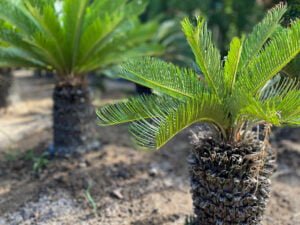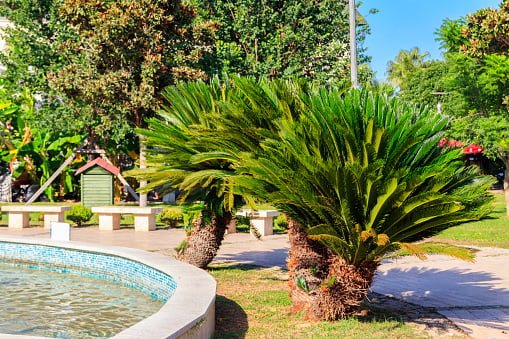Pygmy date palm
The pygmy date palm tree is a subtropical spreading palm that reaches a height of 6.5 feet and a width of 5 feet. It will probably grow 5-6 feet tall as an indoor plant. It has fine leaves and a lovely trunk, ideal for indoor use in cooler climes. The drupes are tasty and produced by female plants.
Because this plant enjoys medium to high light, it should be planted in wet, well-drained soil and protected from the scorching afternoon sun. During the growing season, keep the soil moist but not soggy, as this might lead to root rot. This plant prefers to be slightly root-bound and dislikes being repotted regularly. It enjoys medium humidity as well but has pest issues. In the winter, stay away from cold draughts.
The pygmy date palm tree (Phoenix roebelenii) is a member of the Arecaceae family, which includes over 2,600 species found in tropical and subtropical areas worldwide. Because of its beautiful form and height of 6 to 10 feet, pygmy palms are employed in a range of interiorscapes and commercial plantings (1.8-3 m.).
According to Pygmy date palm literature, this genus is known as a date palm because some species of Arecaceae have sweet, sticky fruit pulp. Phoenix is only a small part of the Arecaceae family, with only roughly 17 species in its genus.
Pygmy Date Palm trees have delicate yellow blooms that give way to tiny purplish dates born on a narrow, solitary trunk with a crown of rich green fronds. On the leaf stalks, little thorns sprout.
Pygmy Date Palm Trees: How to Grow Them
Because this palm tree is native to Southeast Asia, it thrives in USDA zones 10-11, similar to the climate in that region.
Temperatures in USDA zones 10-11 rarely fall below 30 degrees Fahrenheit (-1 degrees Celsius); nevertheless, the tree has been found to live in USDA zone 9b (20 to 30 degrees Fahrenheit or -6 to -1 degrees Celsius) without extensive frost protection. However, during the summer months in the Midwest, pygmy palms can be used as a container specimen on a deck or patio but must be overwintered indoors before the first frost. Pygmy date palm trees grow along riverbanks in the sun to partial shade and, as a result, require a lot of water and a lot of organic soil to thrive.
How to Take Care of a Pygmy Date Palm
To care for a pygmy date palm, keep it watered regularly and put it in sandy, well-drained soil in full sun to full shade. When planted in soil with a pH greater than 7, the tree may suffer from magnesium or potassium insufficiency, which manifests itself as chlorotic or spotted fronds. Pygmy palms have a moderate drought tolerance and are mainly disease and pest-resistant; nonetheless, they are susceptible to leaf spot and bud rot.
Pygmy Palm Tree Pruning
The pygmy palm tree’s up to 6-foot (1.8-meter) long fronds may need to be tamed occasionally. Pruning pygmy palm plants is a simple process that regularly removes old or diseased foliage. Because this palm propagates by seed dispersal, other tree upkeep may include cleaning off fallen leaves or removing offshoots.
Pests
On a Pygmy Date palm, look for scale and Spider Mites.
Diseases
When a Phoenix Roebelenii is overwatered, root rot develops.
Soil
Use basic, well-draining indoor potting soil. Mix a little perlite or hard sand into the potting soil to promote drainage.
Pot size
Every few years, in the spring, report an immature Phoenix Roebelenii. A mature plant’s roots are extremely fragile and dislike being disturbed. Keep the Palm in the same pot as it grows older and replaces the top few inches of soil every year. A Phoenix Roebelenii is a spreading plant that can become very top-heavy if not planted in a big container.

[…] Pygmy Date Palm […]